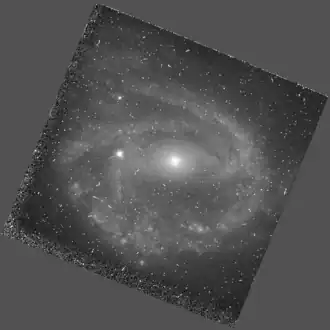NGC 6104
| NGC 6104 | |
|---|---|
 NGC 6104 as seen through the Hubble Space Telescope | |
| Observation data (J2000 epoch) | |
| Constellation | Corona Borealis |
| Right ascension | 16h 16m 30.7s |
| Declination | +35° 42′ 29″ |
| Redshift | 0.028116±0.000100 |
| Heliocentric radial velocity | 8429±30 km/s |
| Galactocentric velocity | 8573±31 km/s |
| Distance | 387.5 million light-years (118 million parsecs) |
| Apparent magnitude (V) | 12.933 |
| Absolute magnitude (V) | -22.65 |
| Characteristics | |
| Type | SB(R)Pec |
| Size | ~ 90,000 light-years |
| Apparent size (V) | 1.80′ × 10.7′ |
| Other designations | |
| IRAS 16146 + 3549, MCG 6-36-11, PGC 57684, UGC 10309 and ZWG 196.20 | |
References: NASA/IPAC extragalactic datatbase, http://spider.seds.org/, http://cseligman.com | |
NGC 6104 is a barred spiral galaxy located in the constellation Corona Borealis. It is designated as S(R)Pec in the galaxy morphological classification scheme, though it is clearly a barred spiral (deserving of the SB(R)Pec designation), and was discovered by William Herschel on 16 May 1787. The galaxy is approximately 388 million light-years away.[1][2][3]
Two supernovae have been observed in NGC 6104: SN 2002de (type Ia, mag. 16),[4] and SN 2019svd (type Ib/c, mag. 19.3).[5]
See also
References
- ^ "Object No. 1 - NGC 6104". NASA/IPAC extragalactic database. NASA/IPAC. Retrieved 3 October 2015.
- ^ "Revised NGC Data for NGC 6104". Seds. Retrieved 3 October 2015.
- ^ "NGC 6104 (= PGC 57684)". cseligman. Retrieved 3 October 2015.
- ^ Transient Name Server entry for SN 2002de. Retrieved 25 March 2023.
- ^ Transient Name Server entry for SN 2019svd. Retrieved 25 March 2023.
External links
 Media related to NGC 6104 at Wikimedia Commons
Media related to NGC 6104 at Wikimedia Commons